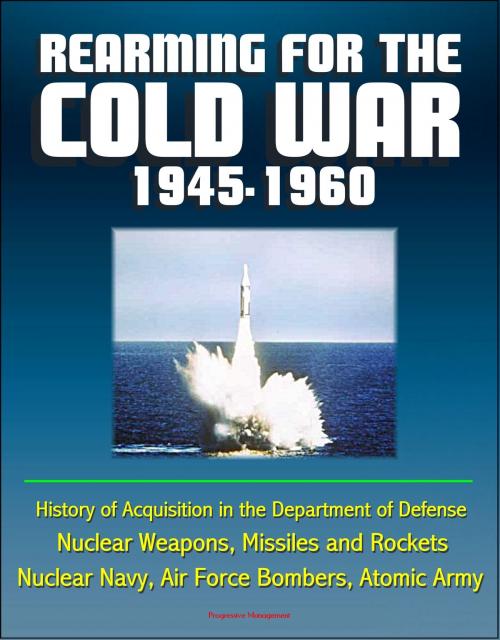Rearming for the Cold War 1945-1960: History of Acquisition in the Department of Defense - Nuclear Weapons, Missiles and Rockets, Nuclear Navy, Air Force Bombers, Atomic Army
Nonfiction, History, Military, Nuclear Warfare, United States| Author: | Progressive Management | ISBN: | 9781301122479 |
| Publisher: | Progressive Management | Publication: | June 24, 2013 |
| Imprint: | Smashwords Edition | Language: | English |
| Author: | Progressive Management |
| ISBN: | 9781301122479 |
| Publisher: | Progressive Management |
| Publication: | June 24, 2013 |
| Imprint: | Smashwords Edition |
| Language: | English |
This volume is a history of the acquisition of major weapon systems by the United States armed forces from 1945 to 1960, the decade and a half that spanned the Truman and Eisenhower administrations following World War II. These instruments of warfare—aircraft, armored vehicles, artillery, guided missiles, naval vessels, and supporting electronic systems—when combined with nuclear warheads, gave the postwar American military unprecedented deterrent and striking power. They were also enormously expensive. A Brookings Institution study estimated that from the end of World War II through the mid-1990s the United States spent over $5 trillion (including the cost of the wartime atomic bomb project) on the development, production, and deployment of nuclear weapons, and on the systems for delivering and defending against them. Twenty percent of that sum was expended between 1945 and 1960.
Although there is a large body of published literature on specific aspects of weapons acquisition, primarily studies of individual systems, no in-depth analysis has yet appeared that combines the histories of the Office of the Secretary of Defense (OSD) and the military services into one account. Such a study is badly needed. World War II was a watershed for acquisition. The postwar defense environment was dramatically different from that existing before the war. So too were the policies, organizations, and processes that governed the acquisition of new weapons. Many of the changes that shaped the nature and course of acquisition through the end of the century were instituted between 1945 and 1960. Additionally, many of the problems that have repeatedly challenged defense policymakers and acquisition professionals since World War II first surfaced during those years. History does not repeat itself exactly; but by revealing long-term trends and the reasons for past choices, it can help illuminate the path forward for those who must grapple with the complex issues surrounding the development, production, and deployment of major weapon systems.
The volume is organized chronologically, with individual chapters addressing the roles of OSD, the Army, Navy, and Air Force in two distinct periods. The first, roughly coinciding with President Truman's tenure, covers the years from the end of World War II through the end of the Korean War in 1953. The second spans the two terms of the Eisenhower presidency from 1953 through early 1961. The year 1953 marked a natural breakpoint between the two periods. The Korean War had ended. President Eisenhower and his defense team began implementing the "New Look," a policy and strategy based on nuclear weapons, which they believed would provide security and make it possible to reduce military spending. The New Look's stress on nuclear weapons, along with the deployment of the first operational guided missiles and the rapid advances subsequently made in nuclear and missile technology, profoundly influenced acquisition in the services throughout the 1950s and the remainder of the century.
I. WORLD WAR II: A WATERSHED * II. ORGANIZING FOR NATIONAL SECURITY: OSD AND ACQUISITION, 1945-1949 * Coordination of Research and Development Prior to the National Security Act * The Research and Development Board * Coordination of Procurement Prior to the National Security Act * The Munitions Board * III. THE RESPONSE TO WAR: OSD AND ACQUISITION, 1950-1953 * Rearmament: Purposes and Organization * Requirements Estimates and Production Schedules * Production Difficulties * The Attack on Production Delays * Production Priorities * Research and Development * IV. MISSION AND MATERIEL: THE ARMY AND ACQUISITION, 1945-1953 * The Army, 1945—1953: An Overview * Organization for Acquisition * Research and Development * Procurement and Production * V. EMERGENCE OF THE WEAPON SYSTEM CONCEPT: THE AIR FORCE AND ACQUISITION, 1945-1953 * The Air Force, 1945-1953: An Overview * Organizing to Exploit Science and Technology
This volume is a history of the acquisition of major weapon systems by the United States armed forces from 1945 to 1960, the decade and a half that spanned the Truman and Eisenhower administrations following World War II. These instruments of warfare—aircraft, armored vehicles, artillery, guided missiles, naval vessels, and supporting electronic systems—when combined with nuclear warheads, gave the postwar American military unprecedented deterrent and striking power. They were also enormously expensive. A Brookings Institution study estimated that from the end of World War II through the mid-1990s the United States spent over $5 trillion (including the cost of the wartime atomic bomb project) on the development, production, and deployment of nuclear weapons, and on the systems for delivering and defending against them. Twenty percent of that sum was expended between 1945 and 1960.
Although there is a large body of published literature on specific aspects of weapons acquisition, primarily studies of individual systems, no in-depth analysis has yet appeared that combines the histories of the Office of the Secretary of Defense (OSD) and the military services into one account. Such a study is badly needed. World War II was a watershed for acquisition. The postwar defense environment was dramatically different from that existing before the war. So too were the policies, organizations, and processes that governed the acquisition of new weapons. Many of the changes that shaped the nature and course of acquisition through the end of the century were instituted between 1945 and 1960. Additionally, many of the problems that have repeatedly challenged defense policymakers and acquisition professionals since World War II first surfaced during those years. History does not repeat itself exactly; but by revealing long-term trends and the reasons for past choices, it can help illuminate the path forward for those who must grapple with the complex issues surrounding the development, production, and deployment of major weapon systems.
The volume is organized chronologically, with individual chapters addressing the roles of OSD, the Army, Navy, and Air Force in two distinct periods. The first, roughly coinciding with President Truman's tenure, covers the years from the end of World War II through the end of the Korean War in 1953. The second spans the two terms of the Eisenhower presidency from 1953 through early 1961. The year 1953 marked a natural breakpoint between the two periods. The Korean War had ended. President Eisenhower and his defense team began implementing the "New Look," a policy and strategy based on nuclear weapons, which they believed would provide security and make it possible to reduce military spending. The New Look's stress on nuclear weapons, along with the deployment of the first operational guided missiles and the rapid advances subsequently made in nuclear and missile technology, profoundly influenced acquisition in the services throughout the 1950s and the remainder of the century.
I. WORLD WAR II: A WATERSHED * II. ORGANIZING FOR NATIONAL SECURITY: OSD AND ACQUISITION, 1945-1949 * Coordination of Research and Development Prior to the National Security Act * The Research and Development Board * Coordination of Procurement Prior to the National Security Act * The Munitions Board * III. THE RESPONSE TO WAR: OSD AND ACQUISITION, 1950-1953 * Rearmament: Purposes and Organization * Requirements Estimates and Production Schedules * Production Difficulties * The Attack on Production Delays * Production Priorities * Research and Development * IV. MISSION AND MATERIEL: THE ARMY AND ACQUISITION, 1945-1953 * The Army, 1945—1953: An Overview * Organization for Acquisition * Research and Development * Procurement and Production * V. EMERGENCE OF THE WEAPON SYSTEM CONCEPT: THE AIR FORCE AND ACQUISITION, 1945-1953 * The Air Force, 1945-1953: An Overview * Organizing to Exploit Science and Technology















